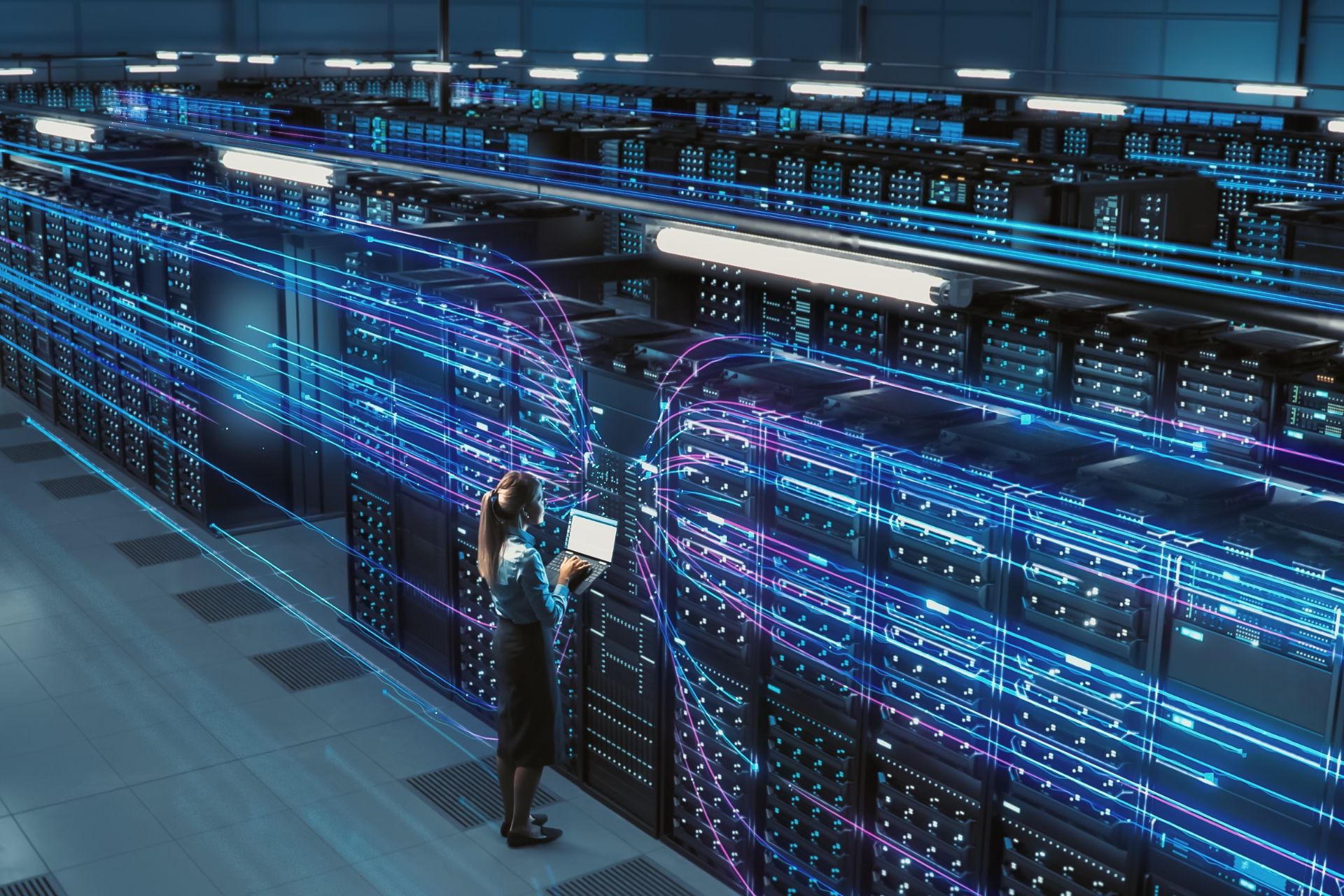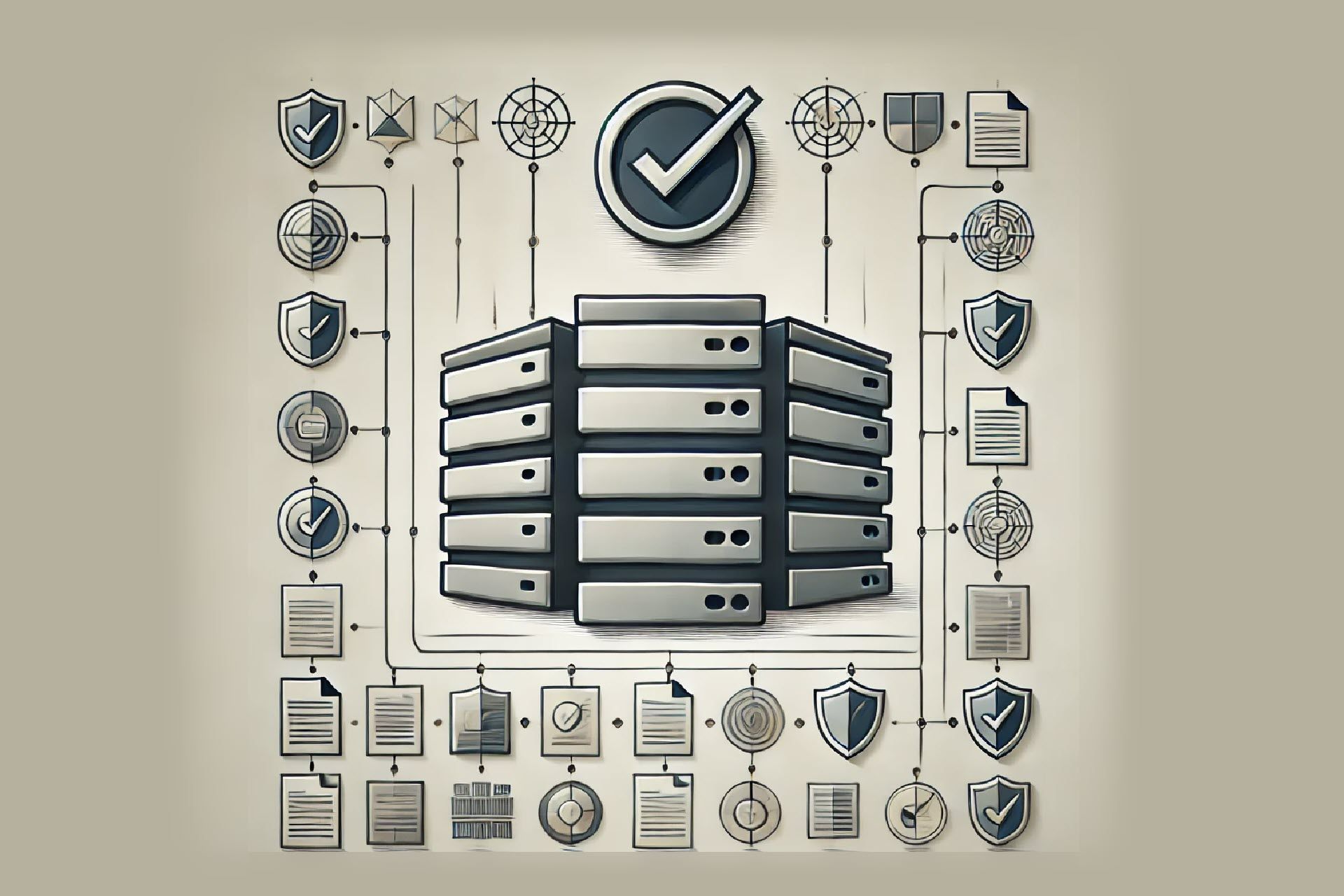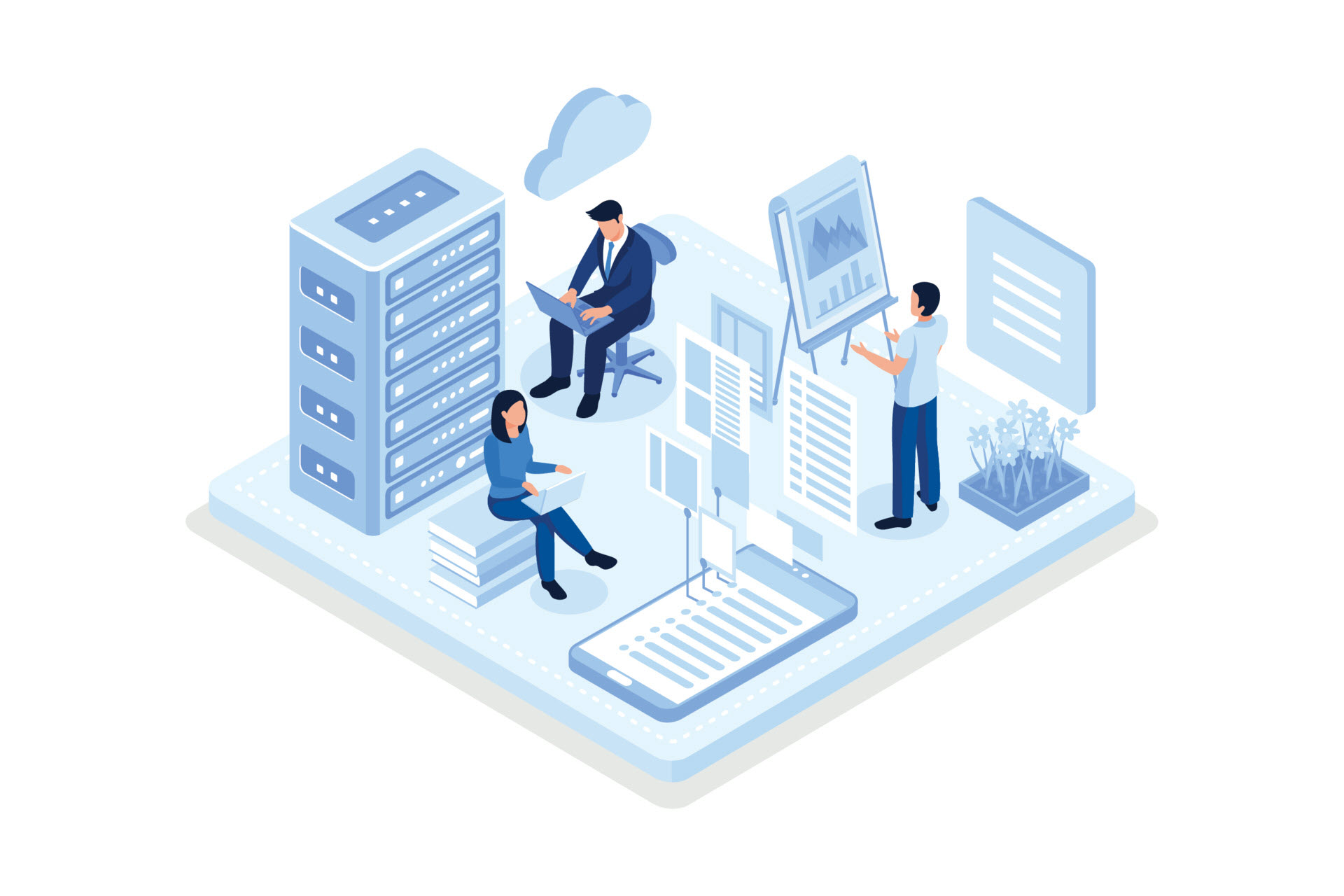Security, capacity, and scalability are rightly prioritized when evaluating data centers. However, power design is a fundamental yet often overlooked element that underpins these considerations.
Electricity is the lifeblood of data centers. It powers the infrastructure responsible for data storage and management. Effective power design is the foundation for optimizing performance, minimizing disruptions, and mitigating security risks.
This article explores data center power design, explaining the hows and whys behind this infrastructure component. Reading it will equip you with the knowledge needed to make informed decisions, regardless of whether you're actively involved in data center selection or just trying to broaden your understanding of this vital element.
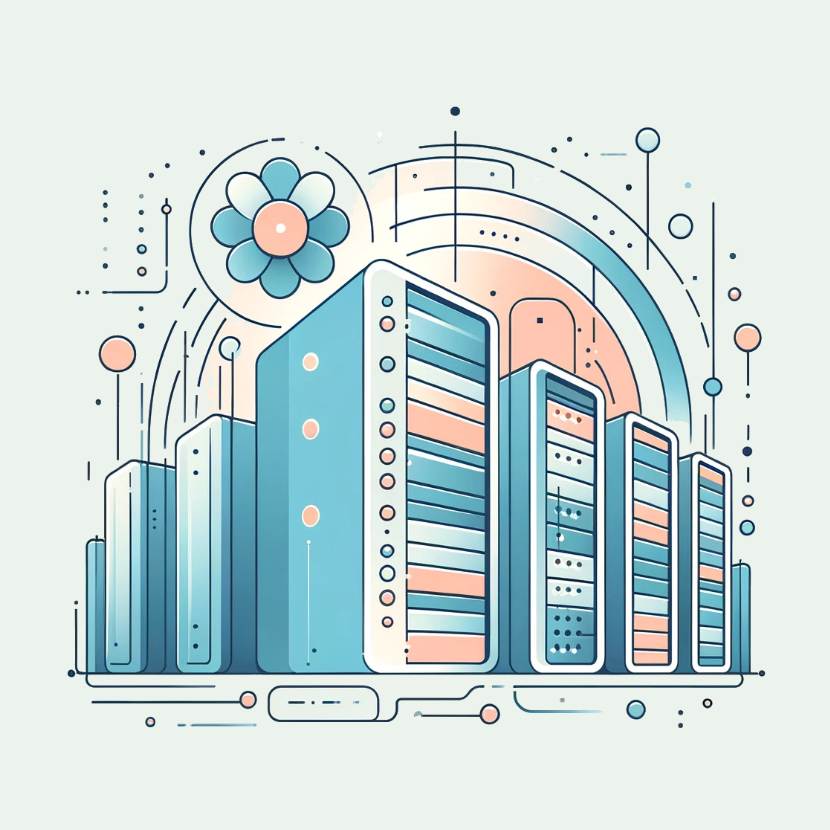
Data Center Power Terminology and Concepts
The table below summarizes the basic concepts of data center power, serving as a foundation for further study.
| Term | Description |
| Power density | Measures the amount of power safely deliverable to a specific area or equipment rack. Measured in watts per square meter (W/m²). |
| Power capacity | Represents the maximum power the data center can supply to its equipment without overload. Measured in watts (W) or kilowatts (kW). |
| Redundancy | Involves duplicating critical power infrastructure components to ensure uninterrupted operation during outages. Examples include generators and Uninterruptible Power Supplies (UPS) systems. |
| Power efficiency | Measures how effectively power is used, aiming to minimize wasted energy. |
| Power distribution | Refers to the process of delivering power to data center equipment. |
| Power monitoring | Utilizes tools and systems to track power usage, temperature, and humidity. |
| Power management | Optimizes power consumption through strategies like load balancing. |
Data Center Power Efficiency KPIs and Metrics
Measuring performance through key performance indicators (KPIs) allows for proactive monitoring, troubleshooting, and optimization.
The table below summarizes essential KPIs for assessing data center efficiency and reliability.
| KPI | Description |
| Power usage effectiveness (PUE) | Measures the total facility power consumption compared to the power used by IT equipment. Lower PUE indicates better efficiency. Often expressed as a ratio (e.g., 1.5 = 1.5x more power used for cooling and infrastructure than IT equipment). |
| Energy efficiency ratio (EER) | Calculates the cooling efficiency of a system, specifically the ratio of cooling output (in watts) to power input (in watts). Higher EER indicates better cooling performance. |
| Reliability | Quantifies the ability of a system or component to perform its intended function without failure over a specific period. Typically expressed as a percentage or probability. |
| Availability | Calculates the time a system or component is operational and accessible for use. Often expressed as a percentage (e.g., 99.99% uptime). |
| Mean time between failures (MTBF) | Measures the average time elapsed between two consecutive system or component failures. Indicates the expected lifespan between failures. |
| Mean time to repair (MTTR) | Measures the average time taken to repair a failed system or component. Lower MTTR signifies faster recovery and improved uptime. |
| Carbon usage effectiveness (CUE) | Estimates the amount of carbon dioxide emitted per unit of energy the data center uses. Lower CUE indicates a lower environmental footprint. Often expressed in grams of CO2 per kilowatt-hour (g/kWh). |
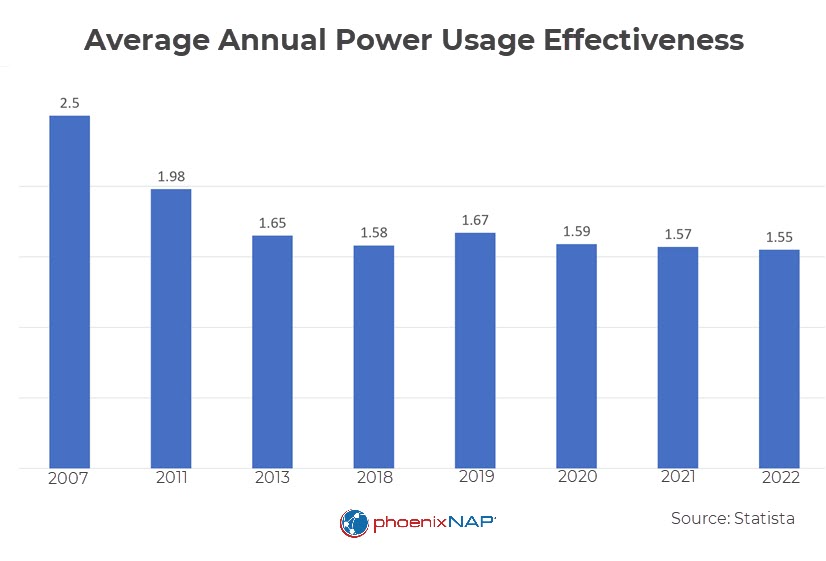
How Much Power Does a Data Center Need?
Data center power requirements vary greatly based on size, server count, and efficiency.
The table below provides a rough overview of data center power requirements.
| Data Center Size | Small | Medium | Large (Hyperscale) |
| Building footprint | 5,000 - 20,000 sq ft | 20,000 - 100,000 sq ft | 100,000 sq ft - millions of sq ft |
| Server count | 500 - 2,000 | 2,000 - 10,000 | 10,000 - 100,000+ |
| Power consumption | 1 - 5 MW (megawatt = one million watts) | 5 - 20 MW | 20 - 100+ MW |
| Design and efficiency | Basic cooling and power management. | Advanced cooling and power management, partial efficiency. | Highly optimized and efficient. |
Data Center Power Usage Breakdown
Data centers require electricity for various operations. Key areas of power consumption include:
- Cooling systems. Data centers use cooling systems to maintain optimal temperatures and prevent hardware failure. These power-intensive cooling systems can be responsible for over 50% of a data center's energy footprint.
- Server operation. Servers require electricity for CPUs, memory, and storage. Storage devices consume power for operation and data transfer, especially in data centers handling large datasets.
- Networking equipment. Routers, switches, and firewalls require power for uninterrupted connectivity.
- Backup power systems. Backup systems like UPS and generators require their own power source.
- Data center security. Security systems rely on electricity for operation. Security equipment includes cameras, access control systems, and alarms.
- Lighting. Data centers require proper lighting for safe and efficient maintenance and operation.
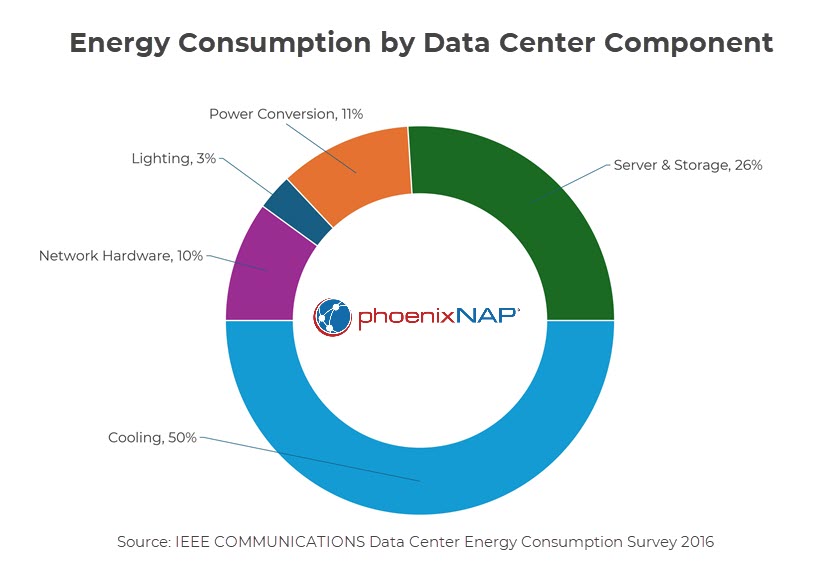
Power Equipment in Data Centers
Here is an overview of the essential equipment for data center power management.
- Transformers. Adjust voltage levels to match the facility's needs, ensuring compatibility with the supplied utility power.
- Power distribution units (PDUs). Serve as a central hub to allocate power from a primary source to various equipment.
- Power cables and connectors. Physically connect equipment and transfer electricity.
- Power breakers. Protect electrical systems from overcurrent or short circuits by interrupting power flow when necessary.
- Uninterruptible power supplies. UPS systems store energy in batteries to provide immediate backup power during emergencies, outages, or voltage fluctuations. UPS systems only provide power for a few minutes until generators become operational.
- Backup generators. Generators offer a secondary, long-term, high-capacity power source during extended outages. The most common types of generators used in data centers are diesel and natural gas-powered. There is usually a 10 to 15-second delay to get them running in the event of a power outage. During this delay, UPS systems provide a cushion and then linearly transfer the load to generators as they come online.
- Automatic transfer switches (ATS). Intelligently and seamlessly switch the power source between the utility grid, generators, and UPS during disruptions.
Data Center Power Distribution Explained
Correctly distributing power is vital for keeping servers and cooling systems running smoothly. This process involves several steps and components to ensure that the high-voltage electricity from the utility grid reaches the IT equipment at a more manageable voltage.
This process involves the following interconnected components:
- Utility feed. Data centers receive power from the local power grid, often with multiple feeds from different grids, to ensure redundancy and prevent a single point of failure. The incoming power is typically high voltage (e.g., 13.8 kV or 33 kV) and is stepped down by transformers to a lower, more manageable voltage suitable for the data center infrastructure.
- Switchgear. The switchgear, including automatic transfer switches, acts as the initial point of contact for utility power within the data center. It distributes the incoming power to the UPS systems and can divide power into smaller circuits for more effective management.
- Transformer. Transformers adjust the voltage to levels suitable for the data center's operation. They can adjust the voltage as required to match the needs of the data center infrastructure.
- Uninterruptible power supply. UPS conditions power and protects against power quality issues such as voltage spikes, surges, and frequency variations. These conditions can damage IT equipment or lead to data loss and data corruption.
- Power distribution units (PDUs). PDUs receive power from UPS systems and convert it to a voltage suitable for the data center's equipment. They distribute power to individual server racks, switches, and other equipment. Data centers usually have multiple PDUs to maintain redundancy.
- Remote power panels (RPPs). RPPs function as localized distribution points, receiving power from PDUs and distributing it further to rack-mounted PDUs (rPDUs) or directly to the equipment. They contain protective elements like fuses, circuit breaker panels, and ground fault protection devices.
- Server racks. Each server rack includes a power strip (rack PDU) that supplies power to the IT equipment within the rack, such as servers, storage systems, and networking devices.
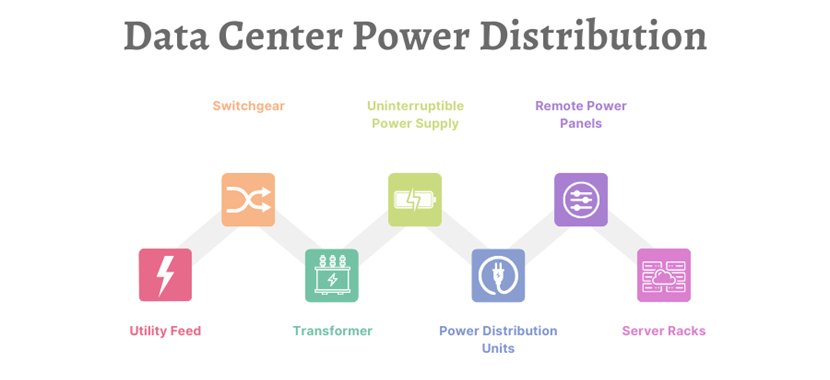
Redundancy and Backup Systems
Redundancy involves duplicating critical components or functions of a system to increase reliability, typically in the form of a backup or fail-safe. In data centers, redundancy is applied to power sources, distribution paths, and network connections, ensuring that if one component fails, another can immediately take its place without affecting the data center.
The primary goal of incorporating redundancy and backup systems is to minimize downtime. Data centers are expected to operate 24/7, and any interruption can lead to financial losses, reputational damage, and disruptions for the entities relying on them.
Data Center Power Design Best Practices
Here are the best practices for designing and maintaining reliable and efficient power systems in data centers.
Backup Generators: Choose Wisely, Maintain Meticulously
Backup generators are your lifeline during extended outages. When choosing generators, prioritize prime rating over standby capacity. This ensures they can continuously deliver their full-rated power, not just for short bursts.
Diesel generators are popular due to their fast startup times and humble fuel needs. However, regular maintenance, fuel quality checks, and battery replacements are crucial to guarantee optimal performance.
Shield Your Data Center from Surges
Lightning strikes and other external surges significantly threaten data center equipment. Implementing surge protection devices on utility panels and establishing comprehensive lightning protection systems throughout the building are essential safeguards.
Separate Critical and Non-Critical Loads
Data centers often house critical and non-critical equipment, each with different power needs. Separating these loads prevents a single point of failure from taking down vital systems.
Static transfer switches, installed at the point of use, guarantee an uninterrupted power supply to crucial devices even during brief outages.
Advanced Breakers for Advanced Protection
Modern breakers and panels offer enhanced fault detection and mitigation capabilities. They can identify and isolate issues faster, protecting entire circuits and individual components.
Right-Sizing Redundancy
The level of redundancy in a data center's power system directly impacts its resilience. Carefully evaluating operational goals and risk tolerance is crucial when determining the appropriate redundancy level. This decision influences the entire layout and selection of power infrastructure components.
Strategically Deploy UPS Systems
Uninterruptible power supply (UPS) systems provide temporary power during outages, bridging the gap until generators come online. However, not all equipment needs UPS protection. Strategically deploying UPS systems based on power density and criticality optimizes costs and minimizes unnecessary downtime.
For instance, protecting the control systems for cooling units with UPS significantly reduces system reboot times after switching to generator power.
Invest in Quality, Invest in Uptime
Choosing high-quality components like superior batteries, adequately sized generators, and robust breaker protection systems is an investment in future reliability. Although initial costs can be higher, these components help lower the risk of unforeseen failures.
Additionally, implementing a well-defined redundancy strategy further bolsters uptime.
Designing and managing data center infrastructure requires specialized knowledge and expertise.
You can skip the complexity of managing your own data center by choosing phoenixNAP colocation. We offer expert-managed, cost-effective solutions to keep your IT running smoothly.

Sustainability and Renewable Alternative Power Options
While critical for the internet and modern life, data centers are major energy consumers. They are responsible for 3% of global electricity use and 2% of greenhouse gas emissions – more than the aviation industry. Burning fossil fuels to generate electricity for data centers contributes significantly to climate change.
This reality necessitates a shift towards sustainable practices. Fortunately, the data center industry is increasingly recognizing this need, placing a growing focus on solutions that reduce the environmental impact of these vital facilities.
Renewable Energy
A key strategy for mitigating the environmental impact of data centers is embracing renewable energy. Switching to clean energy options like solar, wind, and hydropower substantially lowers the carbon emissions associated with data center operations. Numerous prominent technology firms have pledged to power their data centers entirely with renewable energy.
Using renewable energy also reduces greenhouse gas emissions and enhances energy independence for data centers, while helping mitigate the impact of fluctuating energy prices. Approaches to integrating renewable energy include Power Purchase Agreements (PPAs) and deploying on-site renewable energy systems.
Investing in Energy-Efficient Hardware
Adopting energy-efficient hardware is crucial for minimizing energy consumption within data centers. This strategy encompasses a range of equipment, from servers and storage units to networking gear. Furthermore, hardware manufacturers are constantly innovating to produce solutions that consume less power, including energy-efficient processors and advanced cooling methods.
Data center operators can enhance energy efficiency by regularly updating their hardware, consolidating servers via virtualization, and employing smart power management techniques. The move towards energy-efficient hardware helps cut operational costs and supports broader data center sustainability objectives by reducing the overall environmental impact of data center operations.
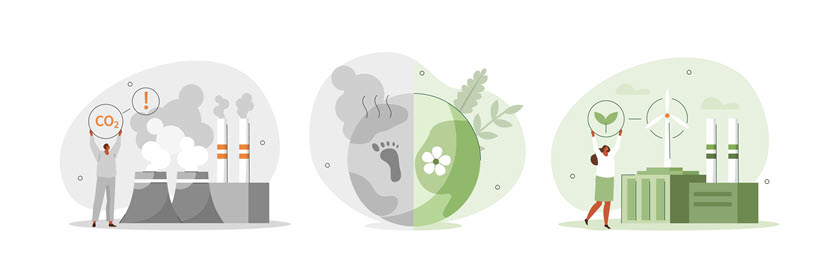
Challenges Faced by Data Centers Today
Data centers are vital to the digital economy. However, as they expand in regions dense with data centers, they encounter significant challenges.
Challenges for Data Center Owners
Here are the key challenges faced by data center owners:
- Grid capacity limitations. Even with a reliable grid and built-in redundancies, areas dense with data centers face limitations in grid-supplied power availability. This bottleneck necessitates exploring alternative power sources to ensure uninterrupted service.
- Economic pressures. The evolving economic landscape, characterized by the downsizing of large tech companies, places a premium on cost-effective power solutions. Both capital and operating expenses are under scrutiny, with the choice of power supply significantly impacting the overall cost of data center operations.
- Environmental impact. The need for additional power complicates environmental compliance, especially if traditional power generation methods are used.
Challenges for Utilities
Here are the hurdles faced by data center utility providers:
- Impact on transmission systems. Providing electricity for data centers requires significant upgrades and expansions of transmission systems and generation capacity. Constructing infrastructure to support data centers is time-intensive and expensive, and costs are often passed on to ratepayers.
- Grid stability. The reliability of the grid remains a constant concern, particularly as renewable energy integration rises and major weather events pose increased risks. Additionally, the expanding demand from data centers and wider electrification initiatives intensifies these challenges.
- Sustainability objectives. Meeting environmental and climate goals is a shared responsibility. Utilities must consider the environmental implications of their power supply options to align with the sustainability objectives of their data center customers.

Read more about colocations and power design.
Powering the Future: How Data Centers are Evolving
As we collectively produce more data, the pressure on data centers to deliver uninterrupted, efficient, and environmentally friendly services intensifies. Data center owners and utilities must collaborate to develop power supply solutions that are rapid to deploy, cost-effective, environmentally friendly, and reliable. Embracing alternative technologies and fuels and adapting infrastructure to accommodate these innovations is essential for meeting the evolving needs of the tech industry and ensuring the sustainable growth of data centers.
Looking ahead, the challenge will be to balance the growing demand for data with the need to reduce environmental impact and operational costs. Meeting this challenge will require ongoing improvement of current technologies and a proactive effort to explore and adopt new power solutions. As data centers continue to underpin the digital economy, their capacity to adapt and evolve will play a pivotal role in shaping the future of technology, commerce, and connectivity.
